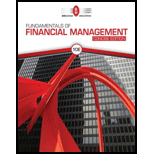
a.
To calculate: Amount in account after 3 years.
Non Annual Compounding:
When the cash flow compounding occurs more than one time in a year than interest rate is divided by number of time compounding occurs in a year. Number of year when multiplied by number of compounding in a year we get compounding period.
b.
To calculate: Two amounts required to make a payment of $4,000 on two equal quarterly deposits in a bank that pays 6% interest rate.
Non Annual Compounding:
When the cash flow compounding occurs more than one time in a year than interest rate is divided by number of time compounding occurs in a year. Number of year when multiplied by number of compounding in a year we get compounding period.
Trending nowThis is a popular solution!

Chapter 5 Solutions
Fundamentals Of Financial Management, Concise Edition (mindtap Course List)
- A key dynamic within any Multi-National Corporation (MNC) is cash and foreign exchange risk exposure. Cash management is critical and also heavily influenced by global dynamics, especially since COVID-19. Within the Caribbean and North American jurisdiction, the economic framework is tightly connected with the major Asian economies of China, the United Kingdom and Japan. The Caribbean and the North American economy have been a barometer of the global economic cycle.) For both Caribbean and North American economies, many Multi-National Corporations have made significant investments to reduce the production cost of goods and diversification benefits. Despite the benefits that could materialize, some North American countries have not been resilient through Global market shocks. Given this context, the following questions require research within the Caribbean context and current market dynamics since COVID-19. Your Manager has asked you to address the following concerns in the report 1)…arrow_forwardJeff Krause purchased 1,000 shares of a speculative stock in January for $1.89 per share. Six months later, he sold them for $9.95 per share. He uses an online broker that charges him $10.00 per trade. What was Jeff's annualized HPR on this investment? Jeff's annualized HPR on this investment is %. (Round to the nearest whole percent.)arrow_forwardCongratulations! Your portfolio returned 16.7% last year, 2.5% better than the market return of 14.2%. Your portfolio had a standard deviation of earnings equal to 18%, and the risk-free rate is equal to 4.4%. Calculate Sharpe's measure for your portfolio. If the market's Sharpe's measure is 0.29, did you do better or worse than the market from a risk/return perspective? The Sharpe's measure of your portfolio is (Round to two decimal places.)arrow_forward
- On January 1, 2020, Simon Love's portfolio of 15 common stocks had a market value of $258,000. At the end of May 2020, Simon sold one of the stocks, which had a beginning-of-year value of $26,900, for $31,400. He did not reinvest those or any other funds in the portfolio during the year. He received total dividends from stocks in his portfolio of $11,900 during the year. On December 31, 2020, Simon's portfolio had a market value of $246,000. Find the HPR on Simon's portfolio during the year ended December 31, 2020. (Measure the amount of withdrawn funds at their beginning-of-year value.) Simon's portfolio HPR during the year ended December 31, 2020, is %. (Round to two decimal places.)arrow_forwardChee Chew's portfolio has a beta of 1.27 and earned a return of 13.6% during the year just ended. The risk-free rate is currently 4.6%. The return on the market portfolio during the year just ended was 10.5%. a. Calculate Jensen's measure (Jensen's alpha) for Chee's portfolio for the year just ended. b. Compare the performance of Chee's portfolio found in part a to that of Carri Uhl's portfolio, which has a Jensen's measure of -0.25. Which portfolio performed better? Explain. c. Use your findings in part a to discuss the performance of Chee's portfolio during the period just ended.arrow_forwardDuring the year just ended, Anna Schultz's portfolio, which has a beta of 0.91, earned a return of 8.1%. The risk-free rate is currently 4.1%, and the return on the market portfolio during the year just ended was 9.4%. a. Calculate Treynor's measure for Anna's portfolio for the year just ended. b. Compare the performance of Anna's portfolio found in part a to that of Stacey Quant's portfolio, which has a Treynor's measure of 1.39%. Which portfolio performed better? Explain. c. Calculate Treynor's measure for the market portfolio for the year just ended. d. Use your findings in parts a and c to discuss the performance of Anna's portfolio relative to the market during the year just ended.arrow_forward
 EBK CONTEMPORARY FINANCIAL MANAGEMENTFinanceISBN:9781337514835Author:MOYERPublisher:CENGAGE LEARNING - CONSIGNMENTPrinciples of Accounting Volume 2AccountingISBN:9781947172609Author:OpenStaxPublisher:OpenStax College
EBK CONTEMPORARY FINANCIAL MANAGEMENTFinanceISBN:9781337514835Author:MOYERPublisher:CENGAGE LEARNING - CONSIGNMENTPrinciples of Accounting Volume 2AccountingISBN:9781947172609Author:OpenStaxPublisher:OpenStax College- Principles of Accounting Volume 1AccountingISBN:9781947172685Author:OpenStaxPublisher:OpenStax College
 Pfin (with Mindtap, 1 Term Printed Access Card) (...FinanceISBN:9780357033609Author:Randall Billingsley, Lawrence J. Gitman, Michael D. JoehnkPublisher:Cengage Learning
Pfin (with Mindtap, 1 Term Printed Access Card) (...FinanceISBN:9780357033609Author:Randall Billingsley, Lawrence J. Gitman, Michael D. JoehnkPublisher:Cengage Learning





